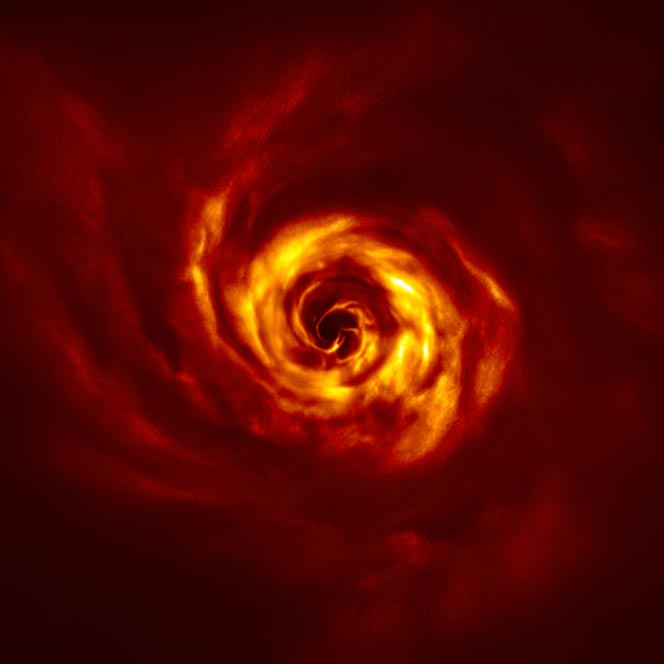
This image shows the disc around the young AB Aurigae star, where ESO’s Very Large Telescope (VLT) has spotted signs of planet birth. Close to the center of the image, in the inner region of the disc, we see the ‘twist’ (in very bright yellow) that scientists believe marks the spot where a planet is forming. This twist lies at about the same distance from the AB Aurigae star as Neptune from the Sun. The image was obtained with the VLT’s SPHERE instrument in polarized light. Credit: ESO/Boccaletti et al.
The Twist Marks the Spot – ESO Telescope Sees Signs of Planet Birth
Observations made with the European Southern Observatory’s Very Large Telescope (ESO’s VLT) have revealed the telltale signs of a star system being born. Around the young star AB Aurigae lies a dense disc of dust and gas in which astronomers have spotted a prominent spiral structure with a ‘twist’ that marks the site where a planet may be forming. The observed feature could be the first direct evidence of a baby planet coming into existence.
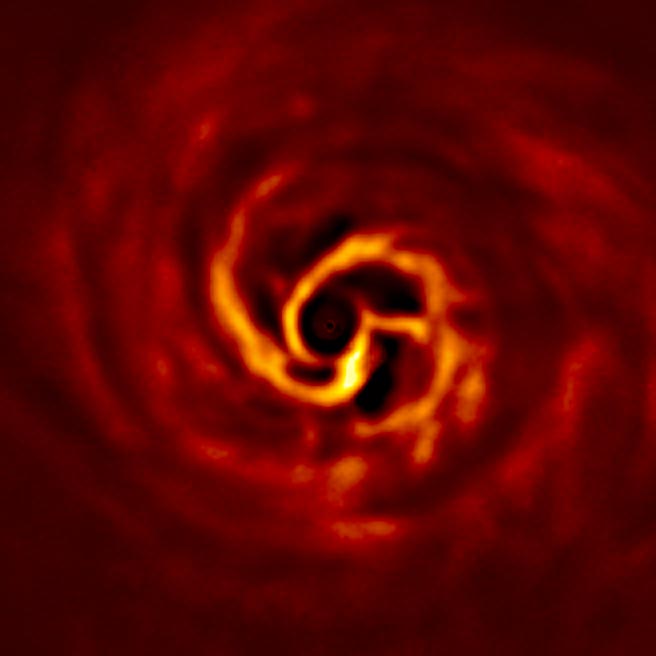
This image shows the inner region of the disc around the young AB Aurigae star, where ESO’s Very Large Telescope has spotted signs of planet birth. The ‘twist’ (in very bright yellow) marks the spot where a planet may be forming. This twist lies at about the same distance from the AB Aurigae star as Neptune from the Sun. The image was obtained with the VLT’s SPHERE instrument in polarized light. Credit: ESO/Boccaletti et al.
“Thousands of exoplanets have been identified so far, but little is known about how they form,” says Anthony Boccaletti who led the study from the Observatoire de Paris, PSL University, France. Astronomers know planets are born in dusty discs surrounding young stars, like AB Aurigae, as cold gas and dust clump together. The new observations with ESO’s VLT, published in Astronomy & Astrophysics, provide crucial clues to help scientists better understand this process.
Observations with ESO’s SPHERE instrument on the Very Large Telescope have revealed the telltale signs of a star system being born.
“We need to observe very young systems to really capture the moment when planets form,” says Boccaletti. But until now astronomers had been unable to take sufficiently sharp and deep images of these young discs to find the ‘twist’ that marks the spot where a baby planet may be coming to existence.
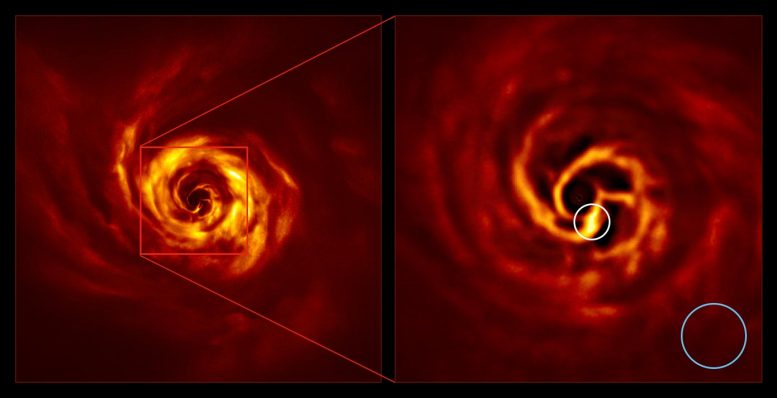
The images of the AB Aurigae system showing the disc around it. The image on the right is a zoomed-in version of the area indicated by a red square on the image on the left. It shows the inner region of the disc, including the very-bright-yellow ‘twist’ (circled in white) that scientists believe marks the spot where a planet is forming. This twist lies at about the same distance from the AB Aurigae star as Neptune from the Sun. The blue circle represents the size of the orbit of Neptune. The images were obtained with the SPHERE instrument on ESO’s Very Large Telescope in polarized light. Credit: ESO/Boccaletti et al.
The new images feature a stunning spiral of dust and gas around AB Aurigae, located 520 light-years away from Earth in the constellation of Auriga (The Charioteer). Spirals of this type signal the presence of baby planets, which ‘kick’ the gas, creating “disturbances in the disc in the form of a wave, somewhat like the wake of a boat on a lake,” explains Emmanuel Di Folco of the Astrophysics Laboratory of Bordeaux (LAB), France, who also participated in the study. As the planet rotates around the central star, this wave gets shaped into a spiral arm. The very bright yellow ‘twist’ region close to the center of the new AB Aurigae image, which lies at about the same distance from the star as Neptune from the Sun, is one of these disturbance sites where the team believe a planet is being made.
This video starts by showing a wider-field view of the AB Aurigae system, and then zooms in to the inner part of the disc. This inner region includes the ‘twist’ (in very bright yellow) that scientists believe marks the spot where a planet is forming. This twist lies at about the same distance from the AB Aurigae star as Neptune from the Sun.
Observations of the AB Aurigae system made a few years ago with the Atacama Large Millimeter/submillimeter Array (ALMA), in which ESO is a partner, provided the first hints of ongoing planet formation around the star. In the ALMA images, scientists spotted two spiral arms of gas close to the star, lying within the disc’s inner region. Then, in 2019 and early 2020, Boccaletti and a team of astronomers from France, Taiwan, the US, and Belgium set out to capture a clearer picture by turning the SPHERE instrument on ESO’s VLT in Chile toward the star. The SPHERE images are the deepest images of the AB Aurigae system obtained to date.
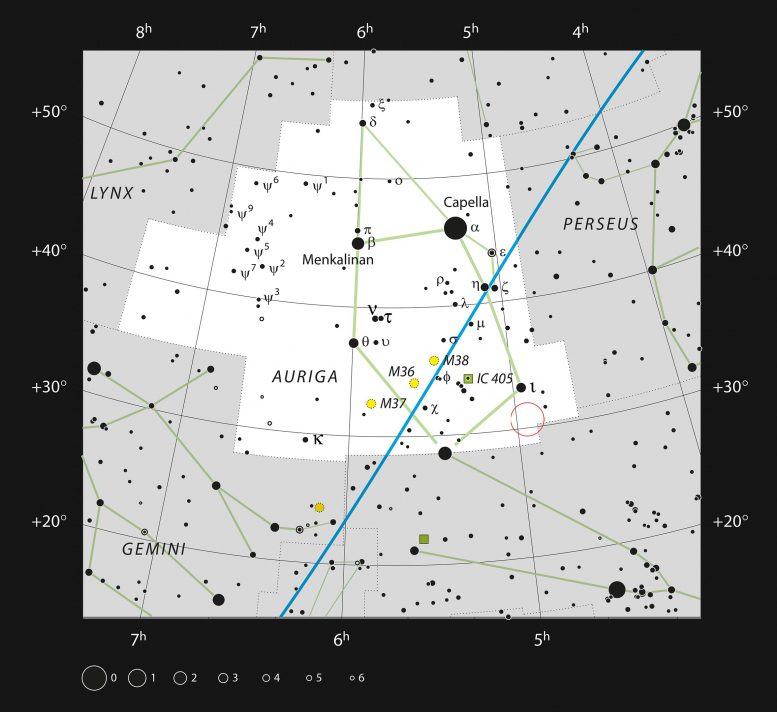
This chart shows the location of the AB Aurigae system. This map shows most of the stars visible to the unaided eye under good conditions and the system itself is marked with a red circle. Credit: ESO, IAU and Sky & Telescope
With SPHERE’s powerful imaging system, astronomers could see the fainter light from small dust grains and emissions coming from the inner disc. They confirmed the presence of the spiral arms first detected by ALMA and also spotted another remarkable feature, a ‘twist’, that points to the presence of ongoing planet formation in the disc. “The twist is expected from some theoretical models of planet formation,” says co-author Anne Dutrey, also at LAB. “It corresponds to the connection of two spirals — one winding inwards of the planet’s orbit, the other expanding outwards — which join at the planet’s location. They allow gas and dust from the disc to accrete onto the forming planet and make it grow.”
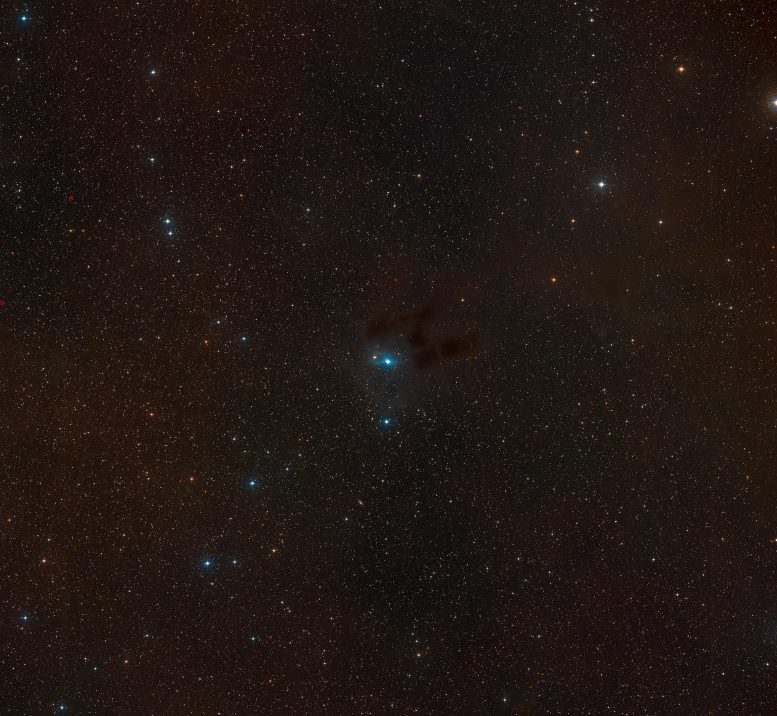
This wide-field view shows the region of the sky, in the constellation of Auriga, where AB Aurigae can be found. This view was created from images forming part of the Digitized Sky Survey 2. Credit: ESO/Digitized Sky Survey 2. Acknowledgment: Davide De Martin
ESO is constructing the 39-meter Extremely Large Telescope, which will draw on the cutting-edge work of ALMA and SPHERE to study extrasolar worlds. As Boccaletti explains, this powerful telescope will allow astronomers to get even more detailed views of planets in the making. “We should be able to see directly and more precisely how the dynamics of the gas contribute to the formation of planets,” he concludes.
This video starts by showing a wide-field view of a region of the sky in the constellation of Auriga. It then zooms in to show AB Auriga, a young star system where ESO’s Very Large Telescope has spotted signs of planet birth.
More information
Reference: “Possible evidence of ongoing planet formation in AB Aurigae – A showcase of the SPHERE/ALMA synergy” by A. Boccaletti, E. Di Folco, E. Pantin, A. Dutrey, S. Guilloteau, Y. W. Tang, V. Piétu, E. Habart, J. Milli, T. L. Beck and A.-L. Maire, 20 May 2020, Astronomy & Astrophysics.
DOI: 10.1051/0004-6361/202038008
The team is composed of A. Boccaletti (LESIA, Observatoire de Paris, Université PSL, CNRS, Sorbonne Université, Univ. Paris Diderot, Sorbonne Paris Cité, CNRS, France), E. Di Folco (Laboratoire d’Astrophysique de Bordeaux, Université de Bordeaux, CNRS, France [Bordeaux]), E. Pantin (Laboratoire CEA, IRFU/DAp, AIM, Université Paris-Saclay, Université Paris Diderot, Sorbonne Paris Cité, CNRS, France), A. Dutrey (Bordeaux), S. Guilloteau (Bordeaux), Y. W. Tang (Academia Sinica, Institute of Astronomy and Astrophysics, Taipei, Taiwan), V. Piétu (IRAM, Domaine Universitaire, France), E. Habart (Institut d’astrophysique spatiale, CNRS UMR 8617, Université Paris-Sud 11, France), J. Milli (CNRS, IPAG, Univ. Grenoble Alpes, France), T. L. Beck (Space Telescope Science Institute, Baltimore, MD, USA), and A.-L. Maire (STAR Institute, Université de Liège, Belgium).
ESO is the foremost intergovernmental astronomy organization in Europe and the world’s most productive ground-based astronomical observatory by far. It has 16 Member States: Austria, Belgium, the Czech Republic, Denmark, France, Finland, Germany, Ireland, Italy, the Netherlands, Poland, Portugal, Spain, Sweden, Switzerland and the United Kingdom, along with the host state of Chile and with Australia as a Strategic Partner. ESO carries out an ambitious program focused on the design, construction and operation of powerful ground-based observing facilities enabling astronomers to make important scientific discoveries. ESO also plays a leading role in promoting and organizing cooperation in astronomical research. ESO operates three unique world-class observing sites in Chile: La Silla, Paranal and Chajnantor. At Paranal, ESO operates the Very Large Telescope and its world-leading Very Large Telescope Interferometer as well as two survey telescopes, VISTA working in the infrared and the visible-light VLT Survey Telescope. Also at Paranal ESO will host and operate the Cherenkov Telescope Array South, the world’s largest and most sensitive gamma-ray observatory. ESO is also a major partner in two facilities on Chajnantor, APEX and ALMA, the largest astronomical project in existence. And on Cerro Armazones, close to Paranal, ESO is building the 39-meter Extremely Large Telescope, the ELT, which will become “the world’s biggest eye on the sky”.
The Atacama Large Millimeter/submillimeter Array (ALMA), an international astronomy facility, is a partnership of ESO, the U.S. National Science Foundation (NSF) and the National Institutes of Natural Sciences (NINS) of Japan in cooperation with the Republic of Chile. ALMA is funded by ESO on behalf of its Member States, by NSF in cooperation with the National Research Council of Canada (NRC) and the National Science Council of Taiwan (NSC) and by NINS in cooperation with the Academia Sinica (AS) in Taiwan and the Korea Astronomy and Space Science Institute (KASI). ALMA construction and operations are led by ESO on behalf of its Member States; by the National Radio Astronomy Observatory (NRAO), managed by Associated Universities, Inc. (AUI), on behalf of North America; and by the National Astronomical Observatory of Japan (NAOJ) on behalf of East Asia. The Joint ALMA Observatory (JAO) provides the unified leadership and management of the construction, commissioning and operation of ALMA.

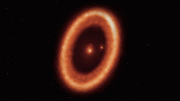
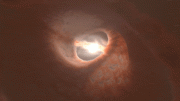
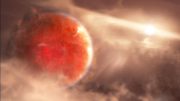
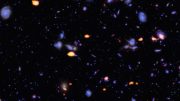
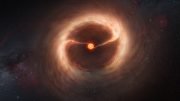

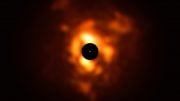
Be the first to comment on "ESO Telescope Sees Telltale Signs of a Baby Planet Coming Into Existence"